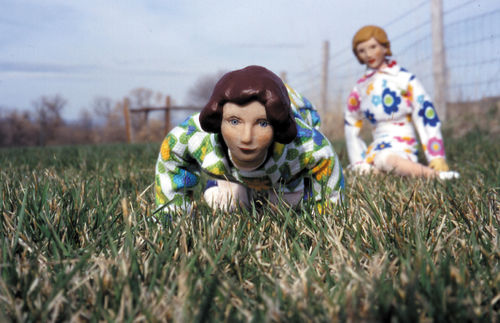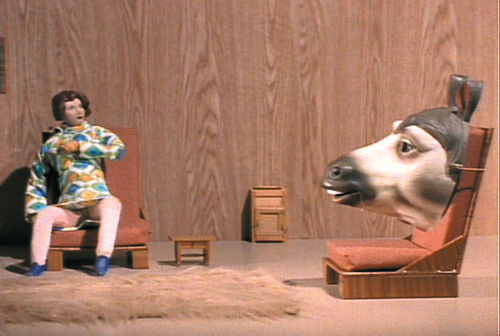
Hammer Projects: Karen Yasinsky
- – This is a past exhibition
In the lobby gallery, Karen Yasinsky exhibited a project entitled Still Life with Cows, which includes an animated video and related works on paper. Using hand-made dolls and sets and stop-action animation she creates a surreal yet somewhat familiar environment where two female figures explore the everyday 'nothingness' of domestic life, desire and relationships.
Hammer Projects are curated by James Elaine.
Biography
Karen Yasinsky was born in 1965 in Pittsburgh. In 1988 she received her B.A. from Duke University, Durham, North Carolina. In 1990 she studied at the New York Studio School, and in 1992 she completed the M.F.A. program at Yale University School of Art. Her work has been exhibited nationally at Casey Kaplan 10-6, the New York Underground Film Festival, and P.S. 1 Contemporary Art Center in New York, and Projekte, Munich; and the Rebecca M. Camhi Gallery, Athens.
Essay
By Laurie Simmons
An uneasy wind blows through Karen Yasinsky's animated films. It rustles clothing indoors and makes green grass wiggle in unnatural ways. It sends tumbleweed rolling east and west. A sense of dislocation and a disturbing tranquility share a stage where everything is in constant motion or very, very still. Her characters are awkward and anatomically incorrect, and sometimes you can see up their skirts. Their arms and legs twitch restlessly, and then suddenly they stand up and twirl like jewelry-box ballerinas. There is no storyboard, no dialogue. Silence and sound alternate, forming a conversation of their own, while the music is most often a chorus of otherworldly voices and instruments - a fitting accompaniment for the ragtag band of magical homemade figures that form Yasinsky's cast.
The opening scene of still life with cows finds a pastoral Wyoming landscape with perfect blue sky. Birds sing and a distant drum beats rhythmically. Two clay-headed women with molded hairdos and colorful print cotton dresses lie in the grass restlessly looking at the sky. Are they sisters? Friends? Lovers? Cut to scene two: The Den. The den has everything it needs—wooden paneled walls, an orange recliner, a beige shag rug, a tiny TV—and yet feels painfully bare. The one piece of art on the wall is a photograph that describes a barren airport landscape. Ms. Brunette-in-a-geometric-print-dress sits in her orange chair wiggling uncomfortably and abruptly tips face-forward onto the shag rug. This sudden fall is reminiscent of the neglected baby who rolls off the ironing board in Yasinsky's first film, DROP THAT BABY AGAIN (1998): a surprising plop in the middle of domestic harmony. Scene three: blue sky, green grass, and voices crooning la-la sounds worthy of a 1960s girl group. Ms. Blonde-in-a-floral-print-dress rests her head on Ms. Brunette's tummy. It is the most beautiful summer day of your life from a not-too-distant past when you could lie in the grass without shoes, without sunscreen, without fear. The dreamy angel voices, the balmy air lull you to a near doze, and then you find yourself abruptly back in the den. Eventually we realize that Ms. Brunette can't walk. We sense that it's a kind of paralyzing vertigo rather than a disability. Ms. Blonde, by contrast, has it all: stature, confidence, and secret smooches for the donkey head that mysteriously appears in a chair. The donkey's silent murmurings seem to finally coax Ms. Brunette to crawl out of the stifling room.
A strong woman and a weak woman spar in a futile competition for power. They meet inside and outside the home, where one woman constantly falls down and the other towers over her. Nothing really ever happens. These are the parameters Yasinsky has given herself for making a story, and as long as seemingly compelling relationships are explored, however ambiguously, one gets the feeling that a linear narrative is unimportant. Stop-motion animation is a plodding and clumsy process. Creating twenty-four frames a second must feel excruciatingly slow when thinking about "moviemaking." Walking, the most difficult action to construct, means screwing each foot down as it takes a step and filling up the hold made by the last step. Perhaps Ms. Brunette is crawling to show us that, without words and without facial expressions, there is no way for the filmmaker to reflect on the sheer tediousness and challenge of the project.
Yasinsky's journey to animation was swift and obvious. The inherent limitations of drawing and painting as a means to convey more than a limited range of emotions became more apparent as the artist searched for new methods to expand her psychological horizons. Her collage drawings of 1993, influenced by Hans Bellmer and Hannah Hoch, show grotesque and fragmented female bodies. The use of old maps, yearbooks, and dog-training and child-rearing manuals as source material influenced the nostalgic mood of the pictures and led her to create her textbook-style illustrations of figures on rice paper in 1995. These characters seemed to float unanchored in time and space, making gesture and facial expression and a sense of rich human interaction her focus. Eventually she found her own rendering of gesture too repetitive and looked toward freeing the style of her characters from their nostalgic source material. In 1998—longing for more emotional power, sound, and a sense of pacing in her work—Yasinsky turned to film. The period from 1998 to 2000 saw the creation of five short films exploring a range of emotions and relationships; they touch on love and lust, friendship and fantasy, and fear and dominance.
Yasinsky has never abandoned drawing, though its role in her work has become more complex. It is both a relief from the technical demands of stop-motion animation and an opportunity to expand the world of her characters when shooting is completed. The drawings that re-create Ms. Blonde and Ms. Brunette from still life with cows allow the women to continue their dance of intimacy as the orange chair replicates itself and they eventually appear as triplets and quadruplets.
In a world where technological advances have made it possible to create animation and special effects on a home computer, one wonders why Yasinsky chose to make her crude, handcrafted, rather tender short films. The mood and look recall Saturday morning TV shows of her (and perhaps her mother's) childhood, with particular references to George Pal's Puppetoons, Gumby, and, more recently, Wallace and Gromit. The themes are almost exclusively domestic, with the exception of the long, long walk of the astronaut in Research of Time's Loss (2000). The simple craft of the drawings and films evoke the work of Ray Harryhausen, who created special effects for The Seventh Voyage of Sinbad (1958) and continued through 1981 with a series of now-classic movies based on Greek and Arabic mythology. His hands-on approach involved classic methods of "trick photography": split screen, super enlargement of tiny objects, and perceptual illusions. With a stark elegance he breathed personality into his creations, rendering them both beautiful and scary. The same can be said for Yasinsky's plain world. In a cartoonish reality she has replaced the expected joy and optimism with sad love and strangeness. Oddness becomes the stuff of child's play. How long we can stand to play in Yasinsky's beautifully simple, quixotic world depends on how many frames of stop-motion animation she can produce per minute.
Laurie Simmons is an artist who lives and works in New York.
Hammer Projects are made possible, in part, with support from The Horace W. Goldsmith Foundation, The Andy Warhol Foundation for the Visual Arts, and the Los Angeles County Arts Commission.






